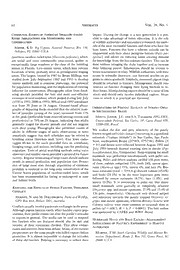
Communal roosts of American swallow-tailed kites: Implications for monitoring and conservation PDF
Preview Communal roosts of American swallow-tailed kites: Implications for monitoring and conservation
, 62 Abstracts VoL. 28, No. 1 Communal Roosts of American Swallow-tailed impact. During the change to a new generation it is pos- Kites: Implications for Monitoring and sible to take advantage of better education. It is the role Conservation ofwildlife authorities and naturalists to research the meth- ods of the most successful fanciers and those who have the Meyer, K.D. Big Cypress National Preserve, Box 710, Ochopee, FL 33943 U.S.A. least losses. Fanciers that have a tolerant attitude can be empowered with facts about peregrine falcons {Falco per- American swallow-tailed kites {ElanoidesJorficatus) which egrinus) and advice on reducing losses creating demand are social and roost communally year-round, gather in for knowledge from the less-tolerant fanciers. This can be exceptionally large numbers at the close of the breeding done without bringing the clubs together and so increase season in Florida. Late-season roosts, which may contain their lobbying power. Information should be written to hundreds of kites, probably serve as premigration staging lessen inaccuracies in relay. Wildlife authorities, with their areas. The largest, located in 1987 by Brian Millsap, was access to scientific literature, can forward articles on pi- studied from July-September 1992 and 1993 to develop geons to create goodwill. Similarly, recovered pigeon rings census methods and to examine phenology, the potential should be returned to fanciers. Management should con- for population monitoring, and the implications ofroosting centrate on fanciers changing their flying methods to re- behavior for conservation. Photographs taken from fixed- duce losses. Manipulating raptors should be a tactic of last wing aircraft provided the best and most cost-effective resort and should only involve individual raptors. Situa- estimates of total numbers, which peaked during late July tions in which it is practical are discussed. (1550 in 1992; 2000 in 1993); 90% of total 1992 attendance was from 20 June to 18 August. Ground-based photo- Observations on Feeding Ecology of Striped Owls graphs of departing flocks revealed that the relative num- in Southeastern Brazil ber of juveniles (young of the year) increased from 17% at the peak (predictable from observed nesting success and Motta-Junior, J.C. and S.A. Talamoni. PPG-ERN, productivity) to 70% on 29 August, indicating that adults Uniuersidade P'ederal, Sao Carlos, SP, Caixa Postal 676, generally staged for shorter periods and did not migrate 73566-050, Brazil with their young. Photographs also permitted counts of We studied the diet and prey selectivity of the poorly adults in different stages of molt; observations at nests known striped owl {Asia clamator) occurring in a grassland tentatively suggest that molt schedules may be related to -savannah (“campo cerrado”) in Sao Carlos, Sao Paulo breeding status (breeders molt later). Five kites radio- tagged 80 km to the south provided data on attendance, S=ta3t1e), asnoudthdeebarsitserwnerBeraczoillle(c2t1e°d58b'eSt,we4e7n°5A2u'gWu)s.tPe1l9l9e2tsa{nNd foraging range, and activity, including cues for predicting July 1993 beneath diurnal roosting sites in shrubs {Pip- migration. Tests of aerial searching methods using naive tocarpharotundifolia, Compositae). Snap-trapping for small observers and smaller roosts provided a protocol for future mammals was performed simultaneously with pellet col- surveys. Regular monitoring oflarge roosts should indicate lecting. Pellet and debris analysis yielded 136 prey items; trends in annual production and population size. Protec- of these, rodents comprised 53%, birds 24%, mouse opos- tion of large roost sites through acquisition of easement sums {Marmosa spp.) 15%, insects 6%, and bats 2%. Bio- probably is essential to the long-term conservation of the = mass estimates (total 3591.8 g) showed rodents (65.6%) United States population of swallow-tailed kites, which and birds (24.1%) to be the most important prey items has been recommended for listing as endangered at state followed by mouse opossums (8.7%), bats (1.4%), and and federal levels. insects (0.2%). It is interesting to point out that many small mammals were partially or completely arboreal Reducing the Effects of Pigeon Fancier/Peregrine (Oryzomys spp. and mouse opossums, 27.9% and 15.4% of Conflict 136 prey, respectively). Chi-square tests showed striped Mooney, N. and M. Holdsworth. Parks and Wildlife, owl selectivity towards the poorly trapped Oryzomys ni- GPO Box 44A, Hobart 7007 Australia gripes and mouse opossums, whereas Bolomys lasiurus and , Calomys callosus were more common in savannah than m AColntfhloiuctgshupsiugaelolyn ifnavnoclievrespraasrseiloynaatfefeecxtchheaanlgtehsy irnaptthoerprpeosps-. wpealsletsspo(nx^so=re6d08b.y5,CdAfP=ES3, aTnd<W0W.F00-0B1r).azTihle.first author ulations, their public claims can alter the public’s attitudes to raptors in general. The media can be used to respond Hurricane Hugo and Bald Eagles—Management but fanciers who are featured should also be met and Implications of Nature’s Experiment in Habitat veracity of their statements checked. This often embar- Alteration rasses and removes them from debate. Many ofthe current perpetrators are the same people who killed raptors before Murphy, T.M. South Carolina Wildlife and Marine Re- protection. It is almost impossible to change the attitudes sources Department, Route 2, Box 767, Green Pond, SC of these old fanciers. Policing is necessary to reduce their 29446 U.S.A.
